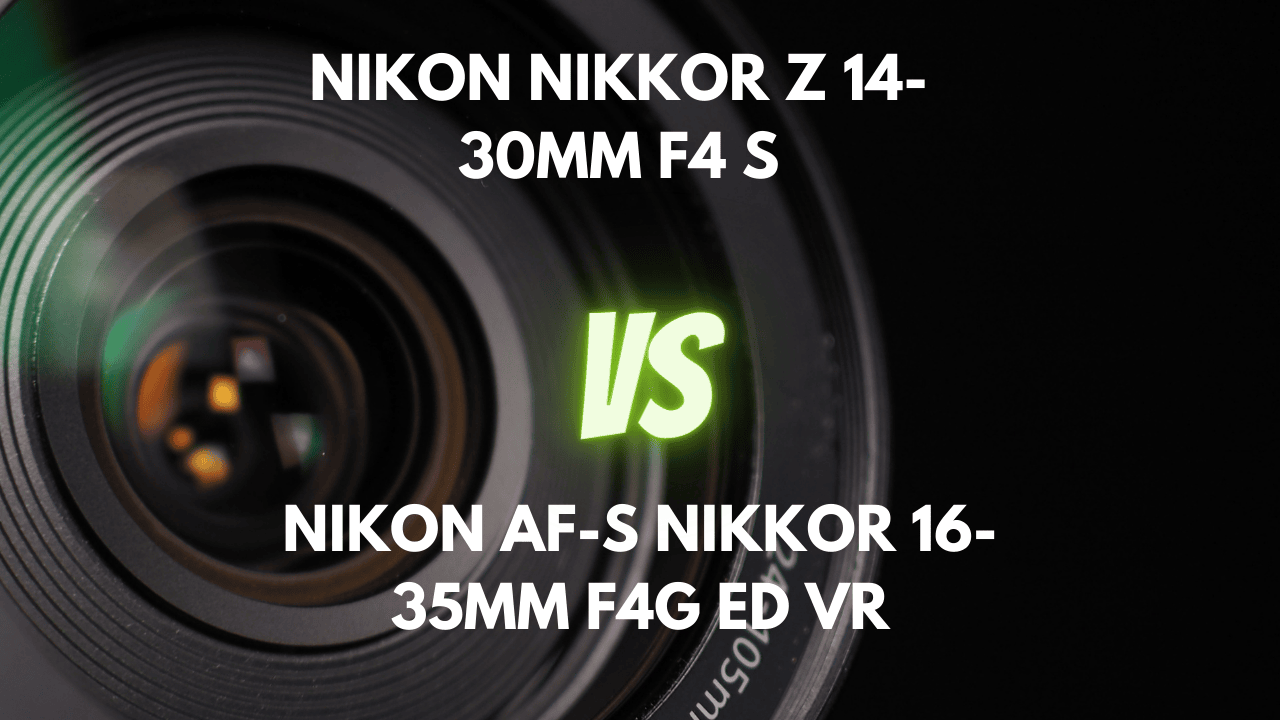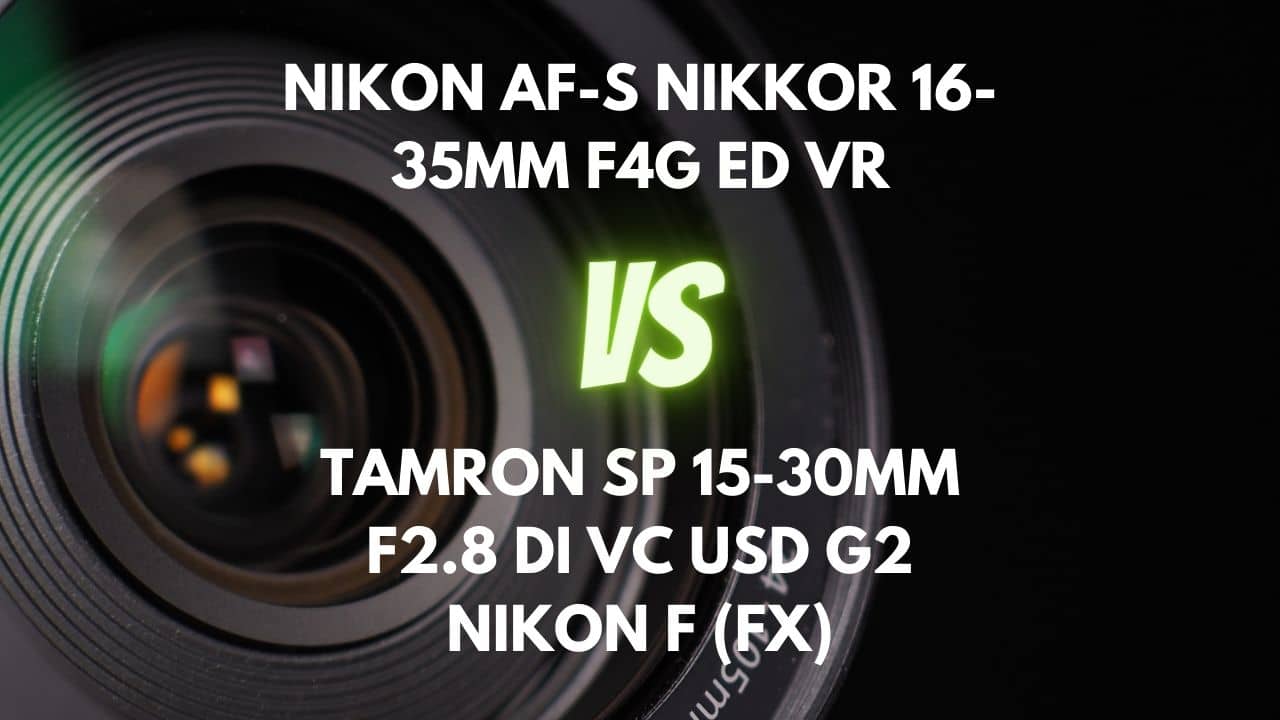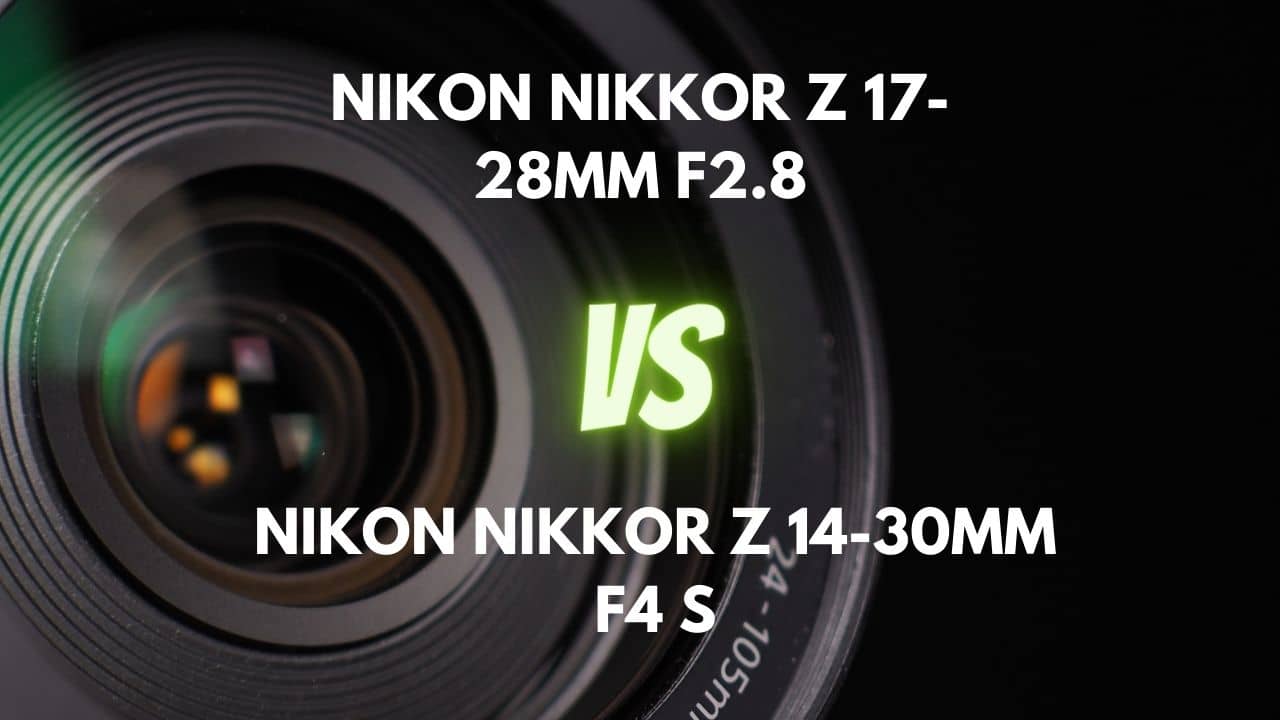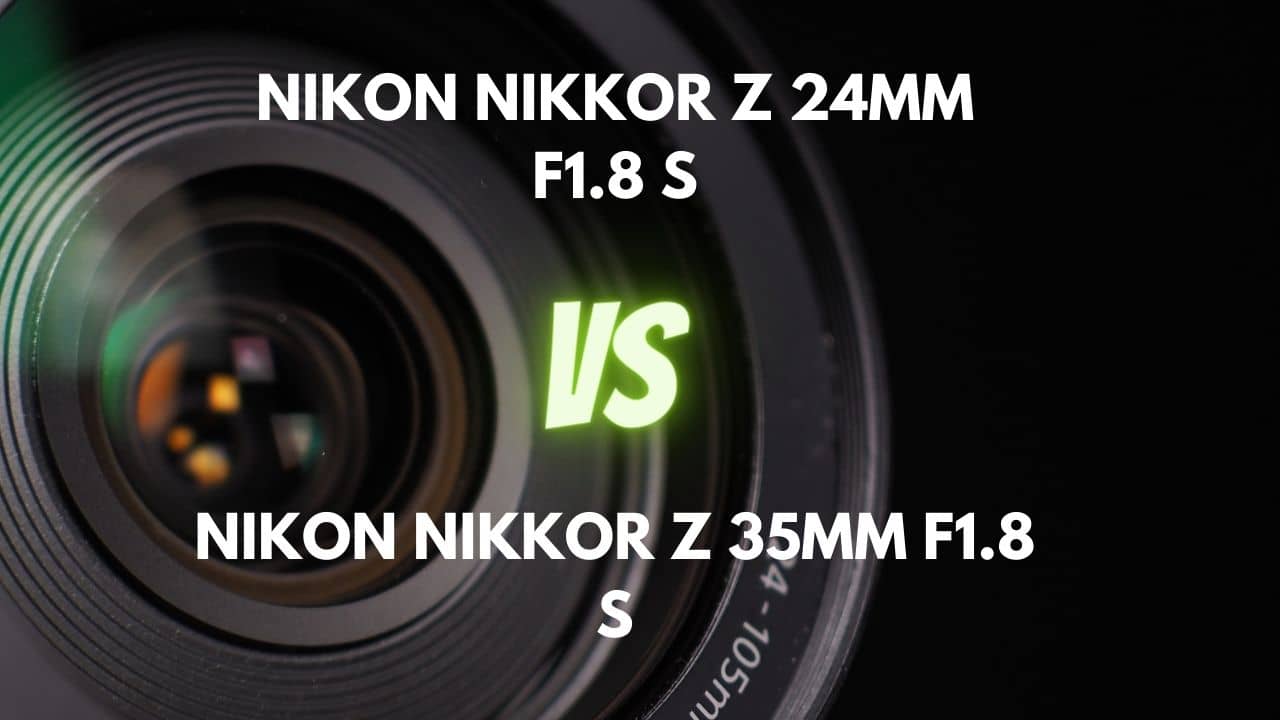Welcome, photography enthusiasts!
Today, we’re diving into the world of wide-angle lenses to explore and compare two of Nikon’s finest offerings: the versatile Nikon Z 14-30mm f/4 S and the fast Nikon Z 14-24mm f/2.8 S.
These two lenses have been making waves in the photography community, each garnering a dedicated fan base with their unique features and performance capabilities.
As we embark on this photographic journey, we’ll be examining the key differences between these two lenses and uncovering what sets them apart.
So, whether you’re a landscape photographer craving an ultra-wide perspective or an architectural aficionado seeking crisp details, join us as we dissect the nuances of these exceptional lenses to help you determine which one is the perfect fit for your creative vision!
Overview
| Nikon NIKKOR Z 14-24mm F2.8 S | Nikon NIKKOR Z 14-30mm F4 S | |
|---|---|---|
| Max Aperture | F2.8 | F4 |
| Aperture Type | Fixed | Fixed |
| Focal Range (mm) | 14-24 | 14-30 |
| Mount Type | Nikon Z | Nikon Z |
| Max Format | 35mm FF | 35mm FF |
| Zoom Ratio (X) | 1.7 | 2.1 |
First, let’s talk about the Nikon Z 14-24mm f/2.8. It’s a fixed aperture lens with a maximum aperture of f/2.8, which means it performs well in low light conditions, allowing for faster shutter speeds or lower ISO settings, resulting in cleaner and sharper images. The focal range is 14-24mm, which gives you a decent amount of flexibility when it comes to wide-angle shots. It’s built for the Nikon Z mount and supports a 35mm full-frame format. The zoom ratio is 1.7x, which isn’t huge, but it’s not bad either.
Now, let’s move on to the Nikon Z 14-30mm f/4. This lens also has a fixed aperture, but with a max aperture of f/4, it might not perform as well in low light situations compared to the 14-24mm f/2.8. However, the focal range is wider at 14-30mm, giving you more versatility when shooting. It’s also designed for the Nikon Z mount and supports a 35mm full-frame format. The zoom ratio here is 2.1x, which is a bit better than the 14-24mm f/2.8.
Both lenses have fixed apertures, so you can expect consistent performance across the entire zoom range. The 14-24mm f/2.8 will be better in low light, thanks to its wider max aperture, and it’ll likely offer sharper images and less distortion, chromatic aberration, and vignetting. However, the 14-30mm f/4 has a wider focal range and a higher zoom ratio, which might be more appealing if you need that extra flexibility.
In summary, if low light performance and image quality are top priorities for you, the Nikon Z 14-24mm f/2.8 is probably the superior lens. But if you’re looking for more versatility in terms of focal range and zoom ratio, the Nikon Z 14-30mm f/4 might be the better choice.
Design and Ease of Use
| Nikon NIKKOR Z 14-24mm F2.8 S | Nikon NIKKOR Z 14-30mm F4 S | |
|---|---|---|
| Diameter x Length (mm) | ⌀88.5×124.5mm | ⌀89×85mm |
| Weight (gr) | 650 | 485 |
| Filter Thread (mm) | 112 | 82 |
| Weather Sealing | Yes | Yes |
| Zoom Method | Rotary (extending) | Rotary (extending) |
| Distance Scale | Yes | No |
| DoF Scale | Yes | No |
| Hood Supplied | Yes | Yes |
| Hood Code | HB-96 | HB-86 |
The Nikon Z 14-24mm f/2.8 is larger, with dimensions of 88.5mm in diameter and 124.5mm in length. It’s also heavier, weighing in at 650 grams. On the other hand, the Nikon Z 14-30mm f/4 is more compact, with dimensions of 89mm in diameter and 85mm in length. It’s lighter as well, weighing just 485 grams.
So, the Nikon Z 14-30mm f/4, with its smaller dimensions and lighter weight, could provide a more comfortable and portable photography experience compared to the Nikon Z 14-24mm f/2.8.
Lens Mount and Barrel
The Nikon Z 14-24mm f/2.8 lens mount is made of solid metal and has a slot at the back for rear gelatin filters. It also features a rubber gasket to prevent dust and moisture from entering the lens barrel.
The mount is well-made, firm in action, and smooth, but not silky smooth. The rear of the lens also has a customizable metallic control ring, a rubberized zoom ring, and a rubberized manual focus ring that works with the focus motor.
The lens barrel is made of a combination of plastic and metal materials. The plastic parts include the cover, zoom ring, and OLED display section, while the rear barrel exterior is made of metal. The lens also features two custom rings and a small screen on top for displaying important information.
Now, let’s take a look at the Nikon Z 14-30mm f/4. Its lens mount is made of metal, and there is a weather-sealing gasket around the edge. The lens barrel is mostly made of plastic with some metal, including chromed metal parts. The front element system extends on a homogeneous tube made of plastic, with a slightly convex 57mm diameter front element surrounded by an inscription with the lens name and parameters, a non-rotating filter thread of 82mm in diameter, and a hood mount. The rear section of the lens, including the mount, is made of metal, and there is a weather sealing gasket around the edge. The lens features a collapsible design that helps keep its size down.
Both lenses have metal lens mounts, which are more durable and can withstand repeated use without becoming damaged or deformed. The Nikon Z 14-24mm f/2.8 has a more complex lens barrel design, incorporating both metal and plastic, whereas the Nikon Z 14-30mm f/4 has a mostly plastic barrel with some metal parts. This difference in materials impacts their weight, portability, and overall feel.
If you prioritize a professional feel and customization options, then the Nikon Z 14-24mm f/2.8 might be a better fit for you. However, if you value portability and a collapsible design, then the Nikon Z 14-30mm f/4 could be the way to go.
Weather Sealing
Nikon Z 14-24mm f/2.8 is fully weather-sealed against dust and moisture. The lens features seals at the base, control rings, buttons, focus mode switch, and joins between various components to provide protection against dust and moisture. There’s a decent sealing gasket on the rear mount and a slot for drop-in gel filters at the back of the lens. The front lens element is protected by a fluorine coating to repel dust, grease, and moisture. Overall, this lens is a reliable choice for outdoor photography, even in dusty or wet environments.
Now, let’s discuss the Nikon Z 14-30mm f/4. This lens is also fully weather-sealed, with a rubber grommet at the lens mount and further special weather sealing throughout the construction, including at the rings, switches, and front of the barrel. It also has a fluorine coating on the front element to repel dust and make it easier to clean. These features make the lens perfect for landscape shooting and professional use.
Both lenses have excellent weather sealing, providing protection against dust, moisture, and light water splashes. They are suitable for outdoor photography in various conditions and offer durability and performance in challenging environments. However, it’s essential to remember that no lens is entirely waterproof, so it’s still important to exercise caution when shooting in extreme conditions.
Rings
First, the Nikon Z 14-24mm f/2.8 lens has 3 rings including a focus ring at the front, a zoom ring in the middle, and a customizable control ring near the base. The rings are well-designed with tough ridged rubber for easy gripping and provide a smooth tactile experience when rotating.
The zoom ring has markings at 14mm, 15mm, 16mm, 18mm, 20mm, and 24mm focal lengths. The focus ring lacks a built-in focus scale but moves smoothly. There’s an OLED display on the lens barrel that shows different information, and the focus ring has a windowed distance scale but lacks a depth-of-field indicator.
Now, let’s discuss the Nikon Z 14-30mm f/4 lens. This lens has two rings: a larger zoom ring and a smaller focus ring.
The zoom ring requires a firm twist to release the lens from its housing and has markings at 14, 16, 20, 24, and 30 mm. It has a shorter throw, requiring less than a quarter of a turn to zoom in and out.
The focus ring can be programmed to control aperture, exposure compensation, ISO, or to be disabled entirely. It has no inscriptions or tactile bevel, but it’s smooth to rotate and easy to focus manually. There are no windowed distance scales or depth-of-field indicators on the focus ring, and no manual focusing distance mentioned.
Comparing the two, the Nikon Z 14-24mm f/2.8 offers more functionality with its customizable control ring, windowed distance scale, and OLED display. Its ridged rubber design provides better grip and tactile feedback. On the other hand, the Nikon Z 14-30mm f/4 has simpler rings, fewer markings, and less tactile feedback. However, it does have a shorter throw, which can be beneficial for quick zoom adjustments.
In conclusion, the Nikon Z 14-24mm f/2.8’s rings are superior in terms of design, functionality, and tactile feedback. The additional customizable control ring and OLED display offer more versatility and convenience for photographers.
Switches
Nikon Z 14-24mm f/2.8 lens features 3 switches designed for easy use and customization.
There’s an AF/MF toggle switch, a programmable L-Fn button, and a Display button. The Display button can be used to change what the OLED information panel shows, switching between focal length, set aperture, and the set focus distance. These switches offer more control and versatility when using the lens.
On the other hand, Nikon Z 14-30mm f/4 lens has a simpler design with an AF/MF switch located at the base, allowing for easy switching between autofocus and manual focus. Although it has fewer switches compared to the 14-24mm f/2.8 lens, it still provides essential functionality for photographers.
In conclusion, the Nikon Z 14-24mm f/2.8 lens has superior switches due to its additional focus mode switch, programmable L-Fn button, and Display button. These extra switches give photographers more control and customization options. However, if you prefer a simpler design with only the essential AF/MF switch, the Nikon Z 14-30mm f/4 lens would be a suitable choice.
Filter Thread
Nikon Z 14-24mm f/2.8 lens includes a plastic hood with filter threads and can accept a 112mm screw-on filter. The HB-97 lens hood is the larger of the two hoods and is compatible with 112mm threaded filters. While this filter size is not standard, Nikon and B+W offer filters in this size. Alternatively, users can opt for trimmable drop-in gel filters that can be inserted into the rear of the lens. Overall, the filter thread is easy to use with compatible filters.
Now, let’s look at the Nikon Z 14-30mm f/4 lens. This lens has a non-rotating filter thread that is 82mm in diameter and is surrounded by an inscription with the lens name and parameters. It is very easy to use with filters, such as polarizers and ND filters, which is great for landscape photography.
The lens allows for attaching filters without the need for a specialist filter holder, making it a very attractive option for travelers of all kinds. The Hoya multicoated HD3 UV filter is recommended as the best protective filter due to its toughness and ability to repel dirt and fingerprints.
In conclusion, the Nikon Z 14-30mm f/4 lens has a superior filter thread. Its 82mm diameter is more common and easier to find filters for, compared to the 112mm filter thread on the Nikon Z 14-24mm f/2.8 lens.
Additionally, the non-rotating design makes it more convenient for using filters like polarizers and ND filters. While the Nikon Z 14-24mm f/2.8 lens does offer alternative filter options like trimmable drop-in gel filters, the convenience and compatibility of the Nikon Z 14-30mm f/4 lens make it a more attractive choice for most photographers.
Focusing and Optical Stabilization
| Nikon NIKKOR Z 14-24mm F2.8 S | Nikon NIKKOR Z 14-30mm F4 S | |
|---|---|---|
| Autofocus | Yes | Yes |
| AF Motor | Stepper motor | Stepper motor |
| Min Focus Distance | 0.28m | 0.28m |
| Max Magnification (X) | 0.13 | 0.16 |
| Full-Time Manual Focus | Yes | Yes |
| Focus Method | Internal | Internal |
Focusing Performance
Nikon Z 14-24mm f/2.8 lens has an autofocus system that is reasonably fast and accurate, producing a quiet sound during operation. It can focus from close-up to infinity in a snap when turned quickly but also makes precise adjustments with a slow turn.
The autofocus is very accurate with no notable errors, and it can focus accurately from a minimum distance of 11 inches, resulting in a maximum magnification of 0.13x. It also has manual focus override, and the manual focus action is smooth.
Now, let’s look at the Nikon Z 14-30mm f/4 lens. This lens has an autofocus system that is quick and quiet, with impressive accuracy and precision, making almost no noise when focusing. The focusing speed is fast and takes around 0.2 seconds to focus from infinity to 0.26m, with no hunting detected.
The autofocus acquisition speed is very good, taking just 0.3 seconds to confirm focus. It can focus accurately and has manual focus override with entirely electronic manual focus action. However, when manually focusing, there can be a noticeable delay in responsiveness. The lens performs well in low-light situations, and the focusing ring turns through 55 degrees with a good grip and no zoom creep.
So, the focusing performance of the Nikon Z 14-24mm f/2.8 and the Nikon Z 14-30mm f/4 is almost the same. Both lenses offer fast and accurate autofocus systems, along with smooth manual focus actions. While there may be minor differences in low-light performance and manual focus responsiveness, these factors do not significantly impact their overall focusing capabilities.
Optical Stabilization
Comparing the optical stabilization of the Nikon Z 14-24mm f/2.8 and the Nikon Z 14-30mm f/4, both lenses do not have optical image stabilization.
Given that optical stabilization is not as crucial for wide-angle lenses and that both lenses can take advantage of the in-body stabilization provided by Nikon Z-mount cameras, the difference in optical stabilization between the two lenses becomes less significant.
Image Quality
| Nikon NIKKOR Z 14-24mm F2.8 S | Nikon NIKKOR Z 14-30mm F4 S | |
|---|---|---|
| Special Elements | 4 ED elements, Arneo + Nano Crystal coatings | 4 ED and 4 aspherical elements + Nano Crystal Coat |
| Diaphragm Blades | 9 | 7 |
Aberration
The Nikon Z 14-24mm f/2.8 performs very well in terms of chromatic aberrations, both lateral and longitudinal. Lateral chromatic aberration is easily corrected in post-processing, and longitudinal chromatic aberration is almost non-existent. This lens also handles spherical aberration and coma well, producing sharp, detailed images with good contrast and minimal distortion. Spherochromatism, which can cause colored fringes on out-of-focus highlights, is not significant in this lens.
On the other hand, the Nikon Z 14-30mm f/4 has strong chromatic aberration correction due to its 4 ED glass elements, and longitudinal chromatic aberration is negligible in out-of-focus areas. However, lateral chromatic aberration is present and more noticeable at the edges of the frame, particularly at 14mm focal length and at wider apertures.
Spherochromatism is present but minimal and should not be a concern for most users. Spherical aberration is noticeable at the maximum focal length and in certain situations, but the depth of field is significant enough to make it difficult to detect in most real-world situations.
Coma, haloing, and color aberrations can also be revealed in night-shots, particularly when rendering point-light sources, but these are not significant weaknesses of the lens.
In conclusion, while both lenses perform well in terms of aberration control, the Nikon Z 14-24mm f/2.8 has a slight edge over the Nikon Z 14-30mm f/4. Its performance in controlling chromatic aberrations, both lateral and longitudinal, as well as its handling of spherical aberration and coma, makes it superior in terms of aberration control.
Sharpness
The Nikon Z 14-24mm f/2.8 is incredibly sharp throughout its range, with excellent center sharpness even at a wide-open aperture. Corner sharpness is good but drops off noticeably wide-open, and there is a slight improvement in extreme corner performance with stopping down.
The sharpest aperture varies depending on the focal length, but typically F5.6 leads to a fairly flat field and most of the frame sharpens up nicely. Diffraction becomes minimally evident at F8, and the overall image starts to appear visibly soft at F11 and beyond. The 14-24mm f/2.8 S is much sharper than the 14-30mm f/4 S, with midframe and corner performance in a different league altogether.
On the other hand, the Nikon Z 14-30mm f/4 offers extremely good overall sharpness at all focal lengths, with the best apertures for center sharpness being f/4 and f/5.6, while the corners are best at f/5.6 and f/8. Sharpness drops slightly at f/11, and again at f/16, but remains good throughout the aperture range, and only becomes problematic when closely examining the image at 100%.
The edge of the frame shows the best sharpness between f/5.6 and f/11. Corner sharpness is weakest at 14mm wide open, but improves noticeably when zooming in, even to 16mm, while center and midframe sharpness remain about the same. At 14mm, the corners never quite reach great performance, though they are never bad. The lens also lacks strong detail in the corners even when stopped down and never quite reaches the sharpness performance of Nikon’s 14-24mm f/2.8 lens.
In conclusion, the Nikon Z 14-24mm f/2.8 is superior in terms of sharpness compared to the Nikon Z 14-30mm f/4, especially when considering midframe and corner performance. While both lenses offer good sharpness, the 14-24mm f/2.8 S stands out as the better performer in this aspect.
Bokeh Quality
When comparing the bokeh quality of the Nikon Z 14-24mm f/2.8 and the Nikon Z 14-30mm f/4, both lenses have their own characteristics, but there are some differences.
The Nikon Z 14-24mm f/2.8 produces bokeh that is generally pleasing, but it can appear busy with a soap bubble effect on specular highlights and a double-edged bokeh in transition zones. It may also show some nisen bokeh at wider apertures. The circle of confusion test suggests that the bokeh is relatively smooth and evenly lit, without onion rings or coloration. While it may be challenging to achieve a very shallow depth of field with this ultra-wide lens, the bokeh that is achievable is still soft and pleasing.
On the other hand, the Nikon Z 14-30mm f/4 is capable of producing some attractive shallow depth of field effects, and at f/4, out of focus areas are rendered smoothly with a pleasing natural drop off. However, it is difficult to get anything out of focus with this lens due to its slow and wide nature. Additionally, the lens lacks significant background separation unless zoomed in and shooting at f/4. In general, the bokeh quality is not a strong point of this lens.
In conclusion, the Nikon Z 14-24mm f/2.8 offers a more pleasing bokeh quality compared to the Nikon Z 14-30mm f/4, although it may not be perfect in some cases. While both lenses can produce bokeh effects, the 14-24mm f/2.8 provides a smoother and more aesthetically pleasing result.
Flare/Ghosting
When comparing the flare and ghosting performance of the Nikon Z 14-24mm f/2.8 and the Nikon Z 14-30mm f/4, both lenses show impressive results.
The Nikon Z 14-24mm f/2.8 performs very well in terms of controlling flare and ghosting, with virtually no loss of contrast, weird reflections, or ghosting even when facing bright light sources. The lens coatings virtually eliminate all flare, ghosting, and coma from light coming in from any direction. It also gives reasonably nice 18-pointed sunstars with well-controlled flare and handles bright light sources coming into the lens very well.
On the other hand, the Nikon Z 14-30mm f/4 also performs exceptionally well against strong light sources, producing minimal flare and ghosting artifacts at both the short and long ends of the zoom range.
In conclusion, both lenses have excellent flare and ghosting performance, but the Nikon Z 14-24mm f/2.8 has a slight edge due to its ability to produce pleasing sunstars and better control of flare and ghosting from light sources coming in from any direction. However, both lenses would serve you well in terms of handling flare and ghosting in various shooting situations.
Vignetting
When comparing the vignetting performance of the Nikon Z 14-24mm f/2.8 and the Nikon Z 14-30mm f/4, both lenses show some degree of vignetting, but they can be managed with proper technique and settings.
The Nikon Z 14-24mm f/2.8 exhibits noticeable vignetting when shooting wide open at f/2.8, but it is minimal and not a deal-breaker. Stopping down to f/4 or smaller reduces the vignetting to reasonable levels even at 14mm and infinity focus, and it’s almost invisible at 18mm and beyond.
The Nikon Z 14-30mm f/4 exhibits some vignetting, especially at 14mm focal length and wide open aperture, but it can be reduced by stopping down to f/5.6 or f/8. The effect is also almost completely gone at 16mm focal length.
However, auto-corrected images in Lightroom will show less vignetting, so it may not be as noticeable in real-world impressions. It’s important to keep in-camera corrections turned on to minimize vignetting, especially when shooting Milky Way images at high ISOs, as correcting for vignetting can add extra noise in the corners.
Distortion
The Nikon Z 14-24mm f/2.8 exhibits noticeable distortion at the widest end of 14mm. There is slight pincushion distortion at the longer end of 24mm, but it is not very prominent. The distortion is not visible when in-camera corrections are enabled, and they are also available for Raw photography.
The Nikon Z 14-30mm f/4 has significant distortion, especially at 14mm where it’s almost 8% barrel distortion, which is quite high. It’s still noticeable across the rest of the zoom range.
The lens profile corrections built into software like Adobe Lightroom and Nikon Capture NX-D may hide this distortion, but it’s still there. However, the lens handles pincushion or barrel distortion at the edges of the frame quite well, and vertical lines remain straight without typical curvature, which is promising.
In conclusion, the Nikon Z 14-24mm f/2.8 performs better in terms of distortion control, especially when considering the in-camera corrections and RAW processing engines.
While the Nikon Z 14-30mm f/4 has significant distortion at 14mm, it can still produce good results with the right software corrections.
Overall, the Nikon Z 14-24mm f/2.8 is superior in terms of distortion control.
Final Verdict
If low light performance, image quality, and sharpness are your top priorities, the Nikon Z 14-24mm f/2.8 is the superior choice. Its bokeh quality, flare/ghosting control, aberration control, and distortion control are also better than the Nikon Z 14-30mm f/4. Moreover, its additional switches and customizable control ring provide more versatility and convenience. However, this lens comes at a much higher price.
On the other hand, if you value versatility in focal range, portability, and a more budget-friendly option, the Nikon Z 14-30mm f/4 might be the better choice for you. It’s smaller, lighter, and has a more common filter thread size of 82mm. While its optical performance is not as strong as the 14-24mm f/2.8, it still delivers good results in various aspects, such as focusing performance and optical stabilization when paired with in-body stabilization.
In conclusion, if you’re willing to invest more money for superior optical performance, customization options, and better control, go for the Nikon Z 14-24mm f/2.8. However, if you prioritize portability, budget, and versatility in focal range, the Nikon Z 14-30mm f/4 would be the more suitable option.






